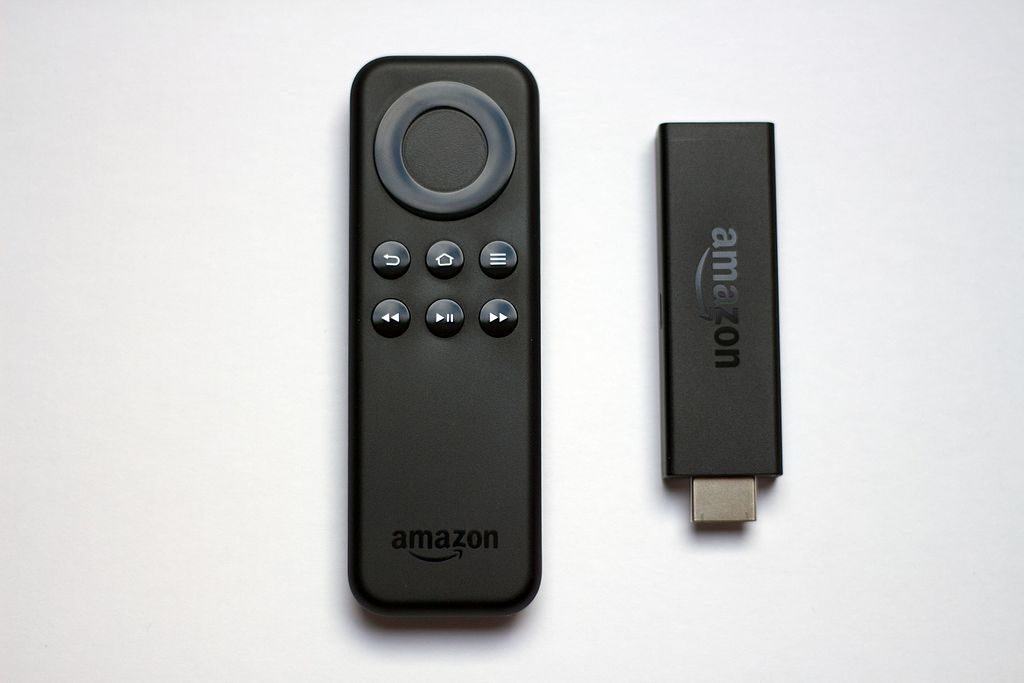
The Amazon Fire TV sticks is a simple and cost-effective way to turn any TV with a USB port into an Internet-connected streaming device with access to tens of thousands of movies, TV shows, and other content. Unfortunately, much of that content is geo-locked, meaning it can only be accessed from specific countries.
That’s where a VPN comes in. By encrypting all of your internet traffic and routing it through an intermediary server in a location of your choosing, you can “spoof” your location to make it appear to the content provider as though you are located in another country or region. This makes it possible to unblock geo-locked content on streaming apps like Netflix, Hulu, Amazon Prime Video, BBC iPlayer, HBO, and many more. Furthermore, users who run Kodi on their Amazon Fire TVs and Fire TV Sticks can hide the contents and destination of their internet traffic from snooping internet service providers.
Amazon Fire TVs and Fire TV Sticks run on a fork of the Android operating system. Many VPN providers make Android apps, but Fire TV doesn’t have access to Google Play in order to download them. The first generation Fire TV Stick doesn’t support VPN apps at all.
In this tutorial, we’ll show you a few different methods Fire TV owners can use to connect their devices to a VPN, unblock geo-locked streaming content, and keep your streaming activity private.
Contents [hide]
- 1 What is the best VPN for Firestick?
- 2 Recommended: subscribe to and install IPVanish
- 3 Other VPNs: Prepare your Amazon Fire TV or Fire TV Stick
- 4 Alternate Method #1: Install VPN app APK on 2nd-gen Fire TV stick and newer via direct download (recommended method)
- 5 Alternative Method #2: Sideload VPN app on 2nd-gen Fire TV Stick and newer with another Android device
- 6 Find the VPN app and connect (following alternative methods #1 and #2)
- 7 No APK or Google Play? Try setting up the VPN on a wifi router
What is the best VPN for Firestick?
If you’ve not already purchased a VPN you’re going to want to make sure you choose one that is up to the job or you may find yourself frustrated. If you don’t want your streaming to be interrupted by buffering (and who does?), you need a fast VPN. Many that we test struggle to deliver suitable speeds. All VPNs will slow your internet connection down, but some more so than others. If you plan on installing the hugely popular open-source media player Kodi on your Fire Stick, you will also want a VPN that works with all Kodi add-ons and protects your privacy should you find yourself downloading any content in a legal gray area.We recommend IPVanish. Out of the dozens of VPNs we’ve tested it’s one of the fastest, scores highly for privacy protection, and works with all Kodi add-ons. It’s also one of the easiest to set up because its app is now on the official built-in app store, which is the by far quickest way.
The other methods are a bit more complicated, but shouldn’t take long to set up with our tutorials by your side. We’re sure you’ll find a way to get your Fire TV or Fire TV Stick connected to a VPN here.
Deal alert: Save 60% on an IPVanish annual plan here.
Recommended: subscribe to and install IPVanish
As of August 2017, the IPVanish app is now available on the Fire TV and Fire TV Stick’s default app store. If you have an IPVanish subscription and a 2nd-generation Fire TV Stick or later, here’s how to get it up and running:- Starting from the home screen, go to Apps > Categories > Utility

- Select IPVanish VPN from the list
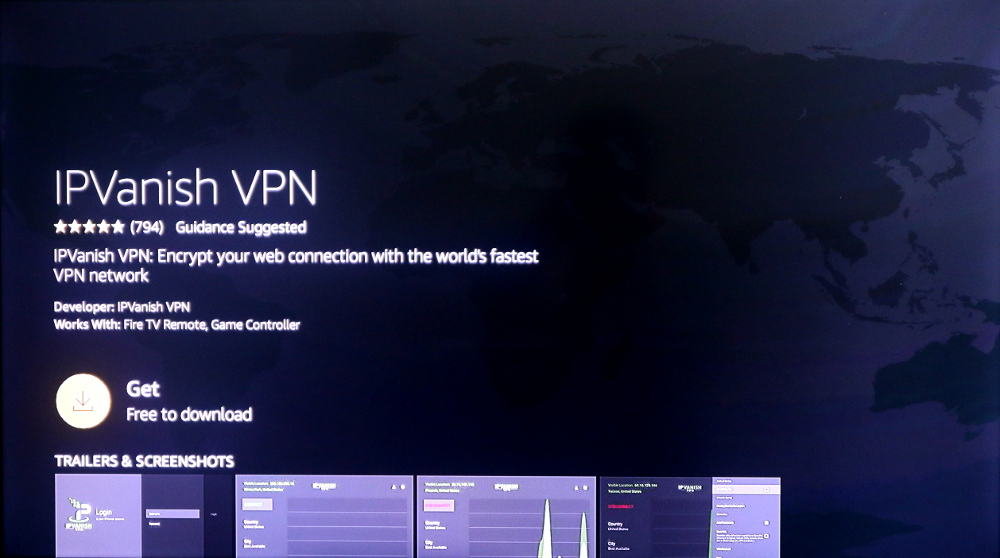
- Click the yellow button next to Get to download and install the app
- Once the app is installed, click the yellow button next to Open on the same page to launch IPVanish
- Enter your IPVanish account username and password. This is a pain with the remote control but you should only need to do it once.
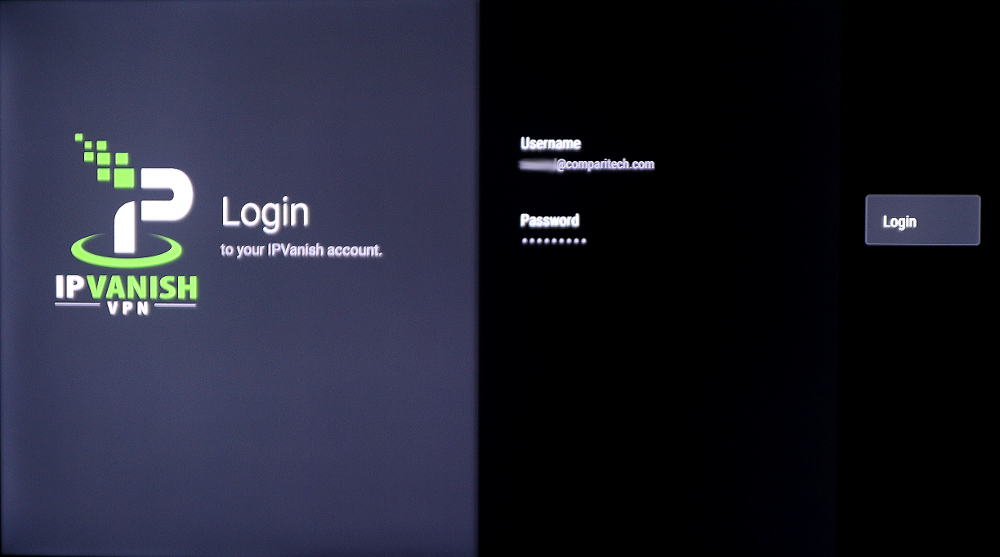
- Click Login
- At this point you can either click the Connect button to connect to the VPN right away, or select a server.
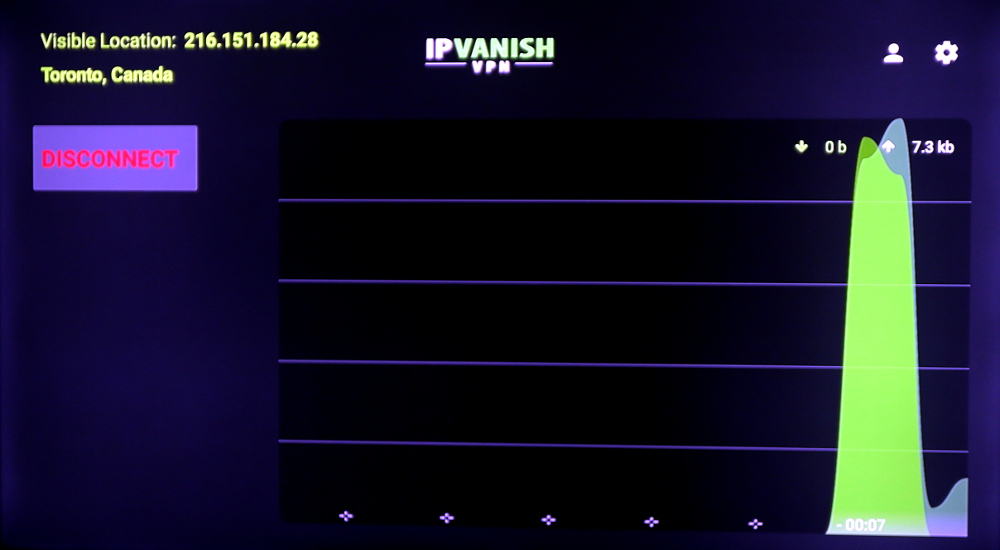
Important reminder: If you’re currently running a side-loaded APK installation of IPVanish VPN for Fire TV (e.g. you previously used one of the alternative methods below), you WILL NOT be able to receive app updates from the Amazon App Store. Instead, you must first uninstall the IPVanish APK before downloading the new native app.
Other VPNs: Prepare your Amazon Fire TV or Fire TV Stick
If you’re using a VPN app that isn’t IPVanish, it probably isn’t listed on the default app store. We’ll show you a couple other ways to get your favorite VPN app on the device.Note: These methods are more complicated and may cause issues with updates. While they will work we recommended sticking to IPVanish and the method described above.
Before we begin, we need to allow the Fire TV to install apps from unknown sources.
1. Boot up your Fire TV and go to Settings > System
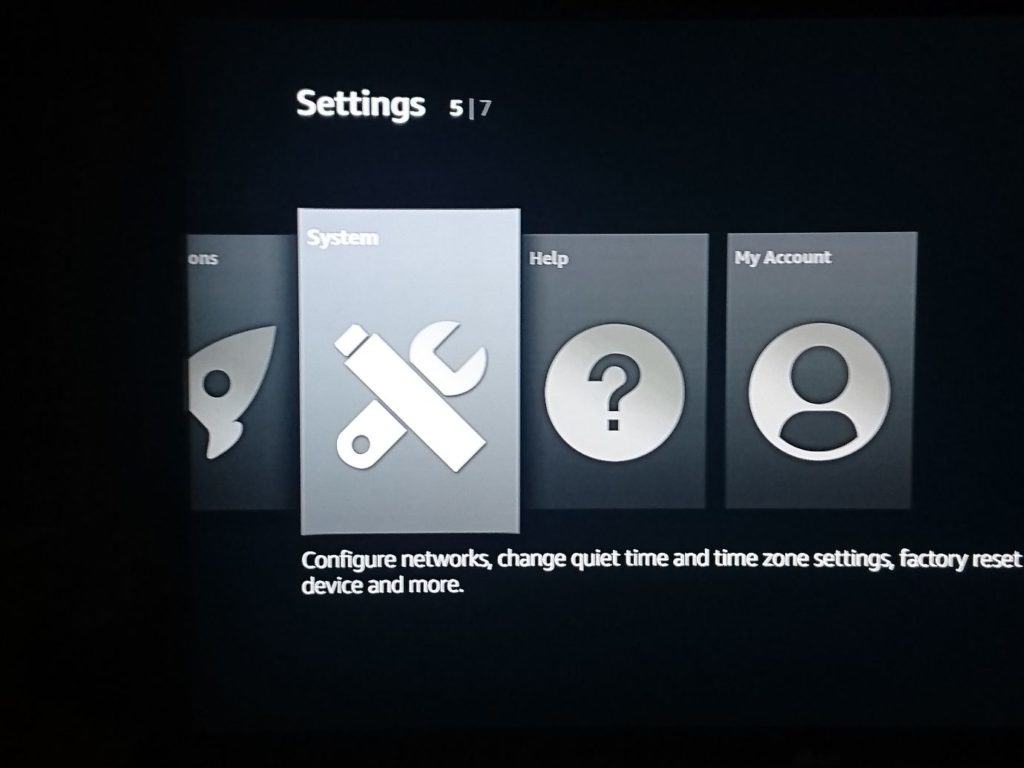 2. Scroll down to Developer Options
2. Scroll down to Developer Options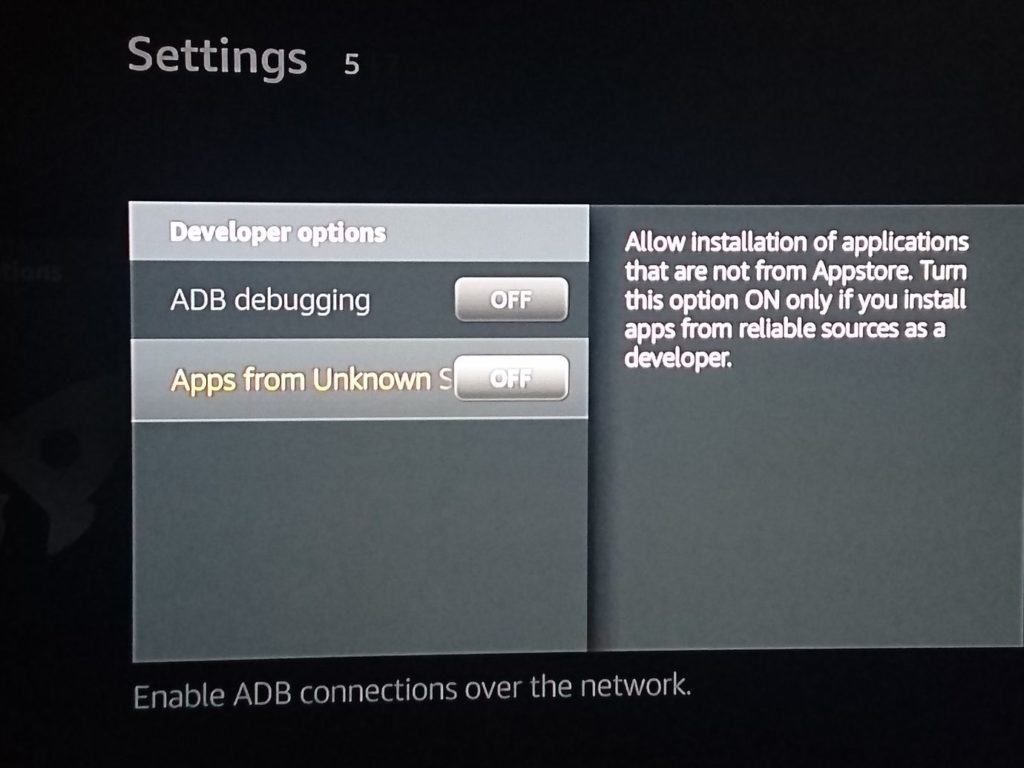 3. Toggle on Apps from unknown sources4. Back out to the System menu again and go to About5. Select Network
3. Toggle on Apps from unknown sources4. Back out to the System menu again and go to About5. Select Network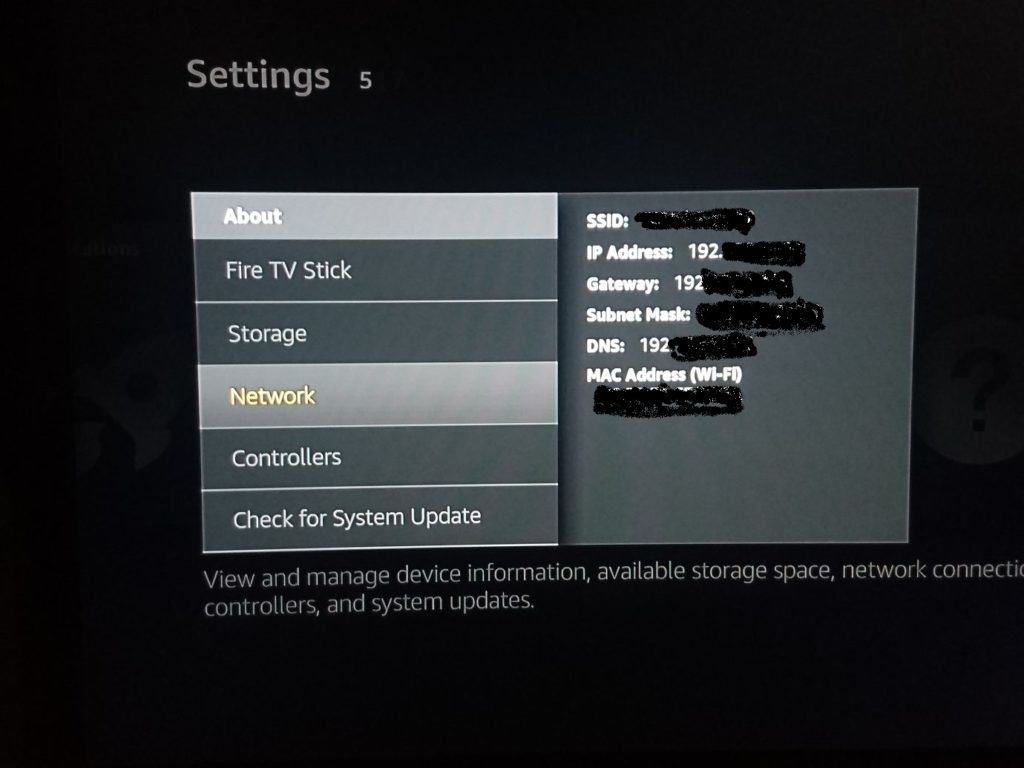
Jot down the IP address of your Fire TV and keep it handy for method #2.
You can now use apps from outside Amazon’s app ecosystem. The most difficult part of this process is actually getting the VPN app onto the Fire TV because Amazon didn’t make it very easy to download APK files or use Google Play. You can choose any of the methods below based on what best suits you.
Alternate Method #1: Install VPN app APK on 2nd-gen Fire TV stick and newer via direct download (recommended method)
This method is easy if your VPN provider makes its Android APK file available via direct download instead of through an app store like Google Play. APK, or Android application package, is the installation file format used by Android devices. We advise you only download APKs directly from the VPN provider’s website. IPVanish, for example, allows customers to download the APK directly from its website. APK files from third parties could be infected with adware or malware. You will need a download URL for the APK file for this method and a 2nd-gen or newer Fire TV Stick. Note that we’ll still use IPVanish as an example here, but we strongly advise IPVanish subscribers to use the recommended Amazon App Store method above.- Boot up your Fire TV and enter “Downloader” into the search bar
- Install the Downloader App, which as of writing has an orange logo
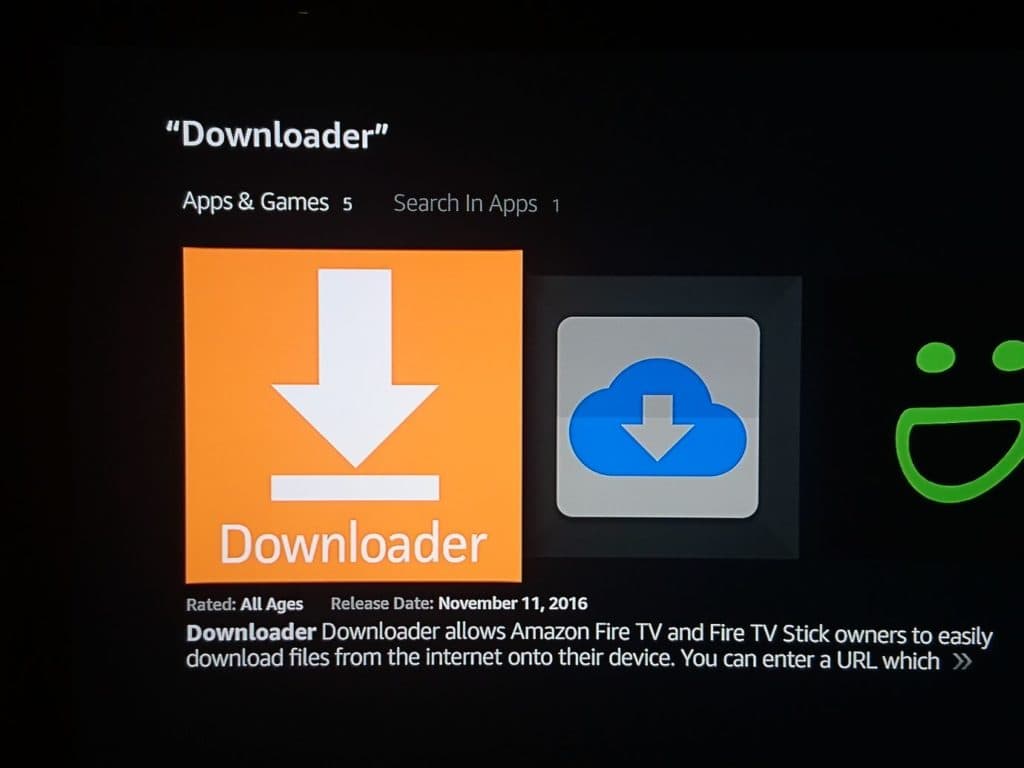
- Open Downloader and enter the direct download URL for the VPN app’s APK file
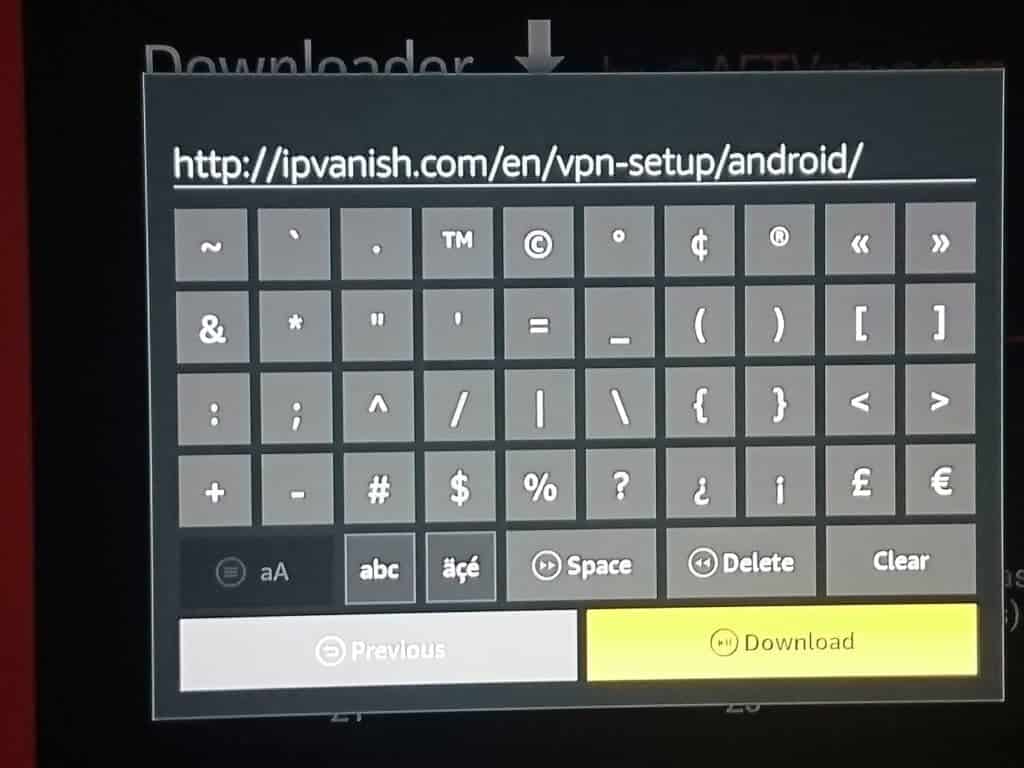
- The VPN app should install automatically, but if not open your downloads in the Downloader app and click the APK file
- The app should be installed and ready to go. Learn where to find it and how to enable it further down
Alternative Method #2: Sideload VPN app on 2nd-gen Fire TV Stick and newer with another Android device
This method requires the second generation of the Fire TV Stick or newer plus a second Android device with access to Google Play, such as a smartphone or tablet. We’ll download the apps to the second device first, then transfer them to the Fire TV using Apps2Fire.If you’re not sure what generation Fire Stick you’re using, look for the model name on the outside. 2nd-gen Fire Sticks have the model name “LY73PR”.
- On your second Android device, download and install Apps2Fire from Google Play
- On the same Android device, download and install the VPN app of your choice from the Google Play Store
- Launch the app and tap the menu icon (three dots) in the top right corner
- Tap Setup
- Under IP address of your Fire TV, enter the IP address you wrote down in step 6 of the previous section
- Tap Save
- Tap the menu icon (three dots) again and select “Upload Apps”
- Tap the VPN app you want to use on your Fire TV to upload it to your Fire TV
- The app should automatically install on your Fire TV. We’ll show you how to find it and enable the VPN in the next section
Find the VPN app and connect (following alternative methods #1 and #2)
Now that the VPN app is installed on your Fire TV, we just need to log in and connect. These steps will vary a bit depending on your VPN provider, but the process is generally the same. The app won’t show up in the top-level Apps menu, unfortunately.- Head back to the starting menu on the Fire TV
- Go to Settings > Applications
- Select Manage installed applications
- Find and select the VPN app you pushed onto the Fire TV
- A sub menu will appear. Select Launch application
- Enter your VPN provider’s login credentials. This might require a keyboard or controller.

- In the VPN app, select a location and hit the connect button. Once the connection is established, you’re good to go!

Updating the VPN app on a Fire TV
One hassle you might encounter with sideloaded Google Play apps and direct download APKs is that they don’t automatically receive updates. If you have a working stable version and it’s secure, then this isn’t so much of a problem. But occasionally you might be forced to update the app. You can compare versions between the “about” or “information” page in the installed app versus the version number listed on Google Play.The process is more or less the same as the steps you took in either method #1 or #2. However before you begin, it’s important to force stop the existing VPN app.
- From the Fire TV home screen, go to Settings > Applications > Manage installed applications
- Find your VPN app, click it, and choose Force stop
- Use method #1 or #2 to push the app onto your Fire TV and install it
- This time, a page will appear that asks if you want to install an update to the existing application along with any new permissions. Select Yes
- After the update, you will have to log back into the app using the steps in the previous section.
No APK or Google Play? Try setting up the VPN on a wifi router
If you can’t find a reliable APK file and don’t have access to Google Play on another Android device, or if you’re using the first-generation Fire TV Stick, your options are limited. There are ways to download APKs using forged device IDs from Google Play using Chrome extensions, then sideloading them with ADB, but that’s more technical than we’re going to get in this article, not to mention you could be violating Google’s terms of service using those methods.Instead, we recommend setting up the VPN on a wifi router instead of the Fire TV. There are two main ways to do this: setting up a virtual router on a laptop or configuring your home wifi router to use a VPN. Virtual routers are easier to set up but require a laptop to route your traffic through, so it’s not exactly convenient. Setting up a VPN on a physical router only works on certain router firmware and can be tricky, but is much more convenient once properly configured. Both methods work with all versions of Amazon Fire TV and Fire TV stick.
Method #3: Connect Fire TV to a VPN-enabled virtual wifi router
Most newer laptops come with the ability to create their own wifi hotspots that other devices can connect to. If the laptop is connected to a VPN, then all of the internet traffic from the devices connected to that hotspot is also tunneled through the VPN server. We’ll show you how to set up a virtual wifi router on Windows and Mac, which you can then connect your Fire TV to. This method works even with the 1st-generation Fire TV and Fire TV Stick.Download and install the desktop VPN app for your operating system from your VPN provider’s website if you haven’t already.
How to set up a VPN-enabled virtual router hotspot on Windows
- First, we need to check to make sure your computer supports virtual routers. In the Windows search bar, type cmd and right click Command Prompt > Run as Administrator
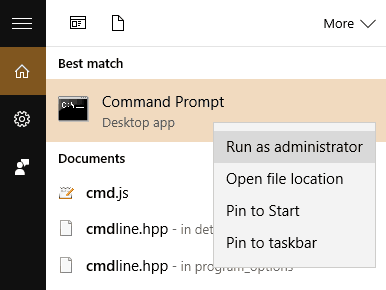
- In the terminal windows that appears, type
netsh wlan show driversand hit /Enter - Look for the line that says Hosted network supported. If it says Yes then you are good to go. If not, you’ll have to set up the VPN on the physical router. Help with that further down.
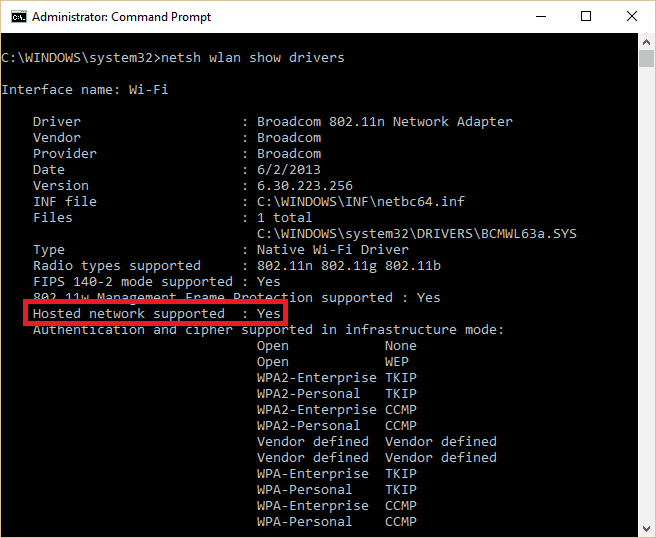
- In the terminal window, type
netsh wlan set hostednetwork mode=allow ssid=<MY-NETWORK> key=<MY-PASSWORD>, replacing <MY-NETWORK> and <MY-PASSWORD> with the network name and password of your choice, and hit Enter.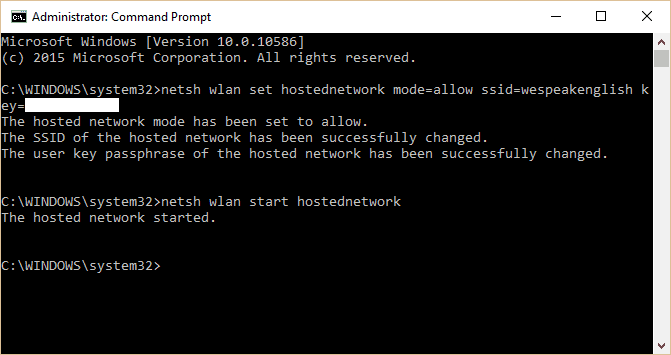
- You should see some text indicating you successfully created the virtual router. To turn it on, type
netsh wlan start hostednetworkand hit Enter - You should get a message that says the hosted network started. If not, you need to update your network adapter drivers and try again.
- Next we need to share the virtual router with other devices. Press Windows Key+R, type ncpa.cpl into the Run prompt, and hit Enter
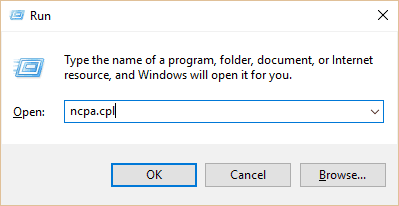
- In the list of connections that appears, look for the one you just created. It will have the network name you put in earlier. Remember or jot down the name of this connection
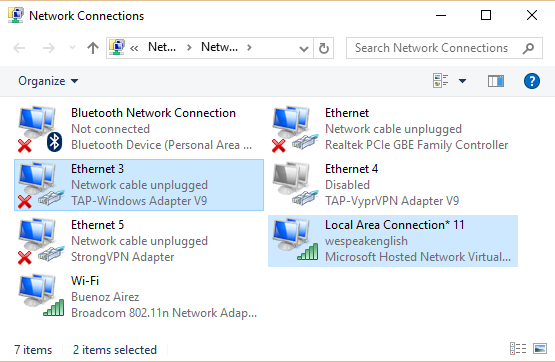
- On the same list of connections, look for the one that says TAP-Windows Adapter. Right click it and select Properties
- Click the Sharing tab at the top and check the box to Allow other network users to connect through this computer’s Internet connection
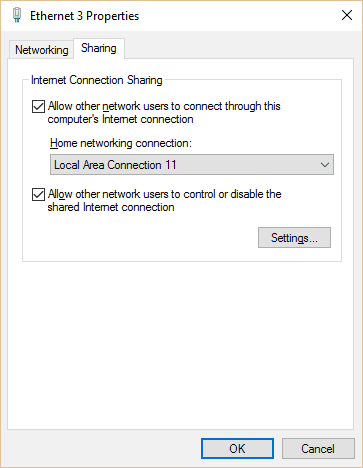
- Under Home network connection, click the dropdown and select the name of the network you created earlier. Press OK
- Open your VPN app, select OpenVPN as the protocol in the settings if needed, and connect to a server in the United States. OpenVPN activates the TAP Windows Adapter
- Your PC is now a VPN-enabled wi-fi router!
- Click the Apple icon to get a system menu, then select System Preferences.
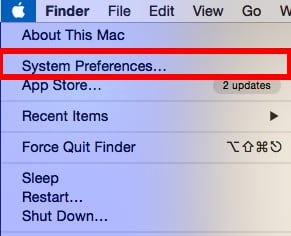
- In System Preferences, click the Network icon.
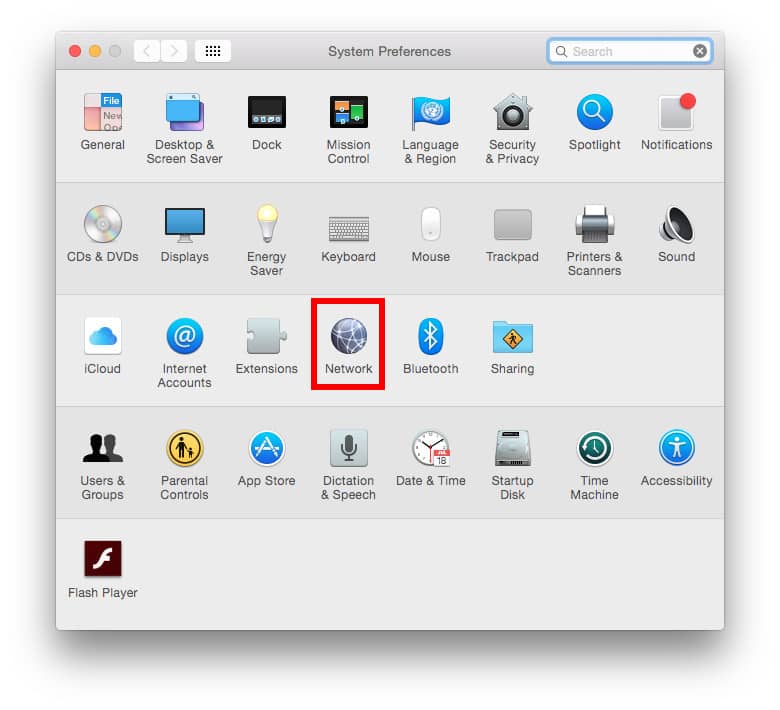
- In the Network window, click on the plus (+) sign at the bottom of the left panel to add a new service. In the pop-up window, select the following options: Interface: VPN, VPN Type: L2TP over IPSec, Service Name: [choose a name for your VPN connection]*
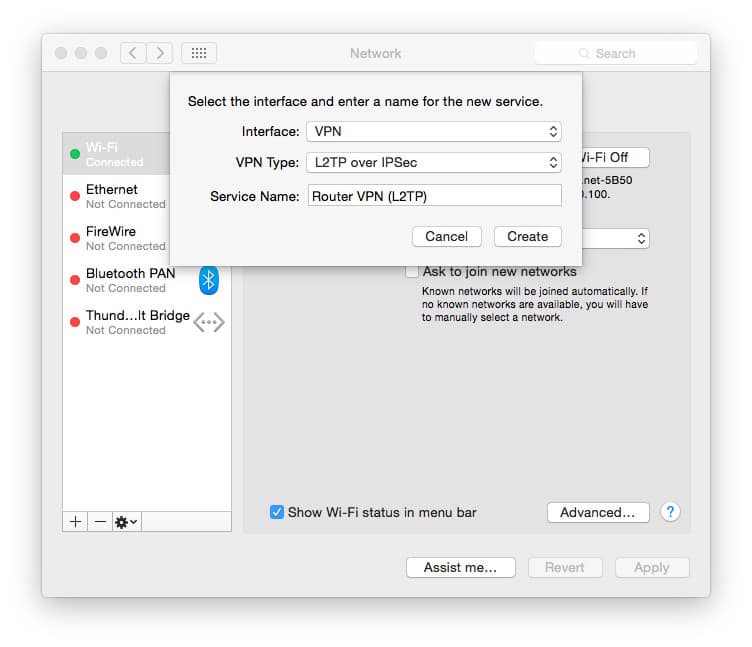
- Click Create. For these next steps you will need your VPN username, password, and a server address. You will probably also need an IPSec key, depending on your VPN provider’s settings, this can also be referred to as a Shared Key or Shared Secret. You can find these under the Manual Configuration section of the VPN provider’s support website. Most providers will also have a list of servers that you can choose from.
- Enter the following details: Configuration: Default, Server Address:[server address as specified by VPN provider], Account Name: [username], Encryption: Automatic (128 bit or 40 bit)
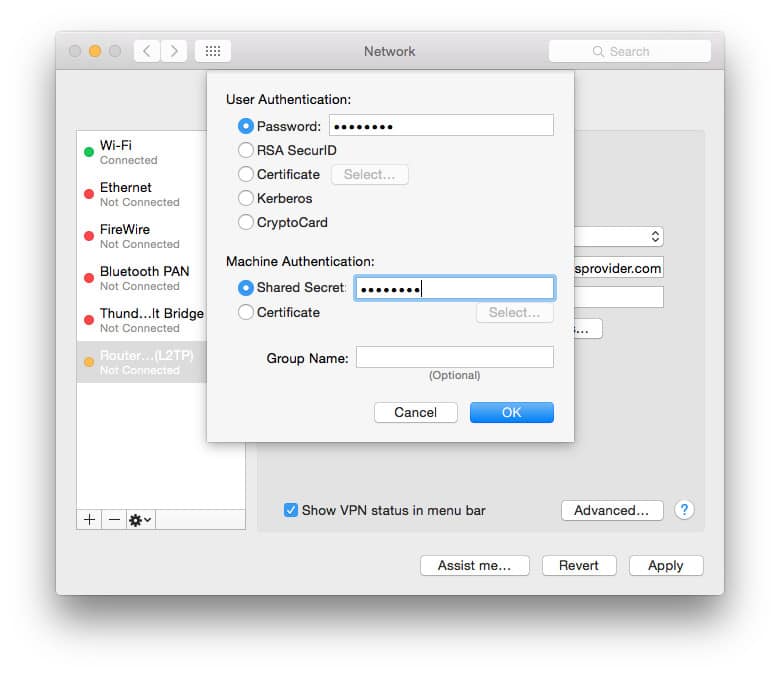
- Check the box next to Show VPN status in menu bar to see your VPN connection status in the menu bar.
- Click on Authentication Settings…. On the User Authentication screen, enter your password in the box and the IPSec key in the Shared Secret box under Machine Authentication, then click OK.
Authentication settings - Next, click on Advanced… Check the box for Send all traffic over VPN connection, then click OK.
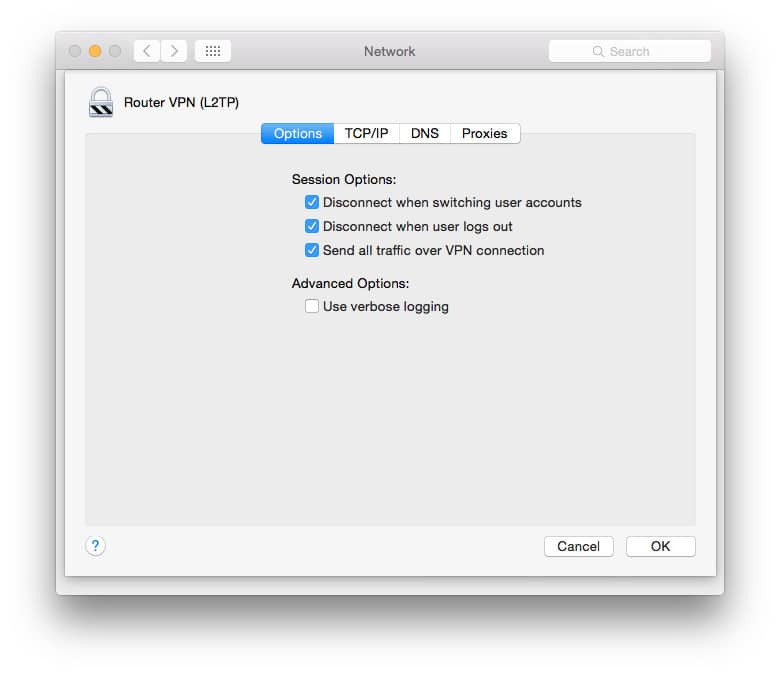
- Click Apply to save all of your settings and then connect to your VPN with the Connect button. You are now connected to a VPN server. Now you just need to set up your VPN for sharing.
- Return to theSystem Preferences menu, then click on Sharing.
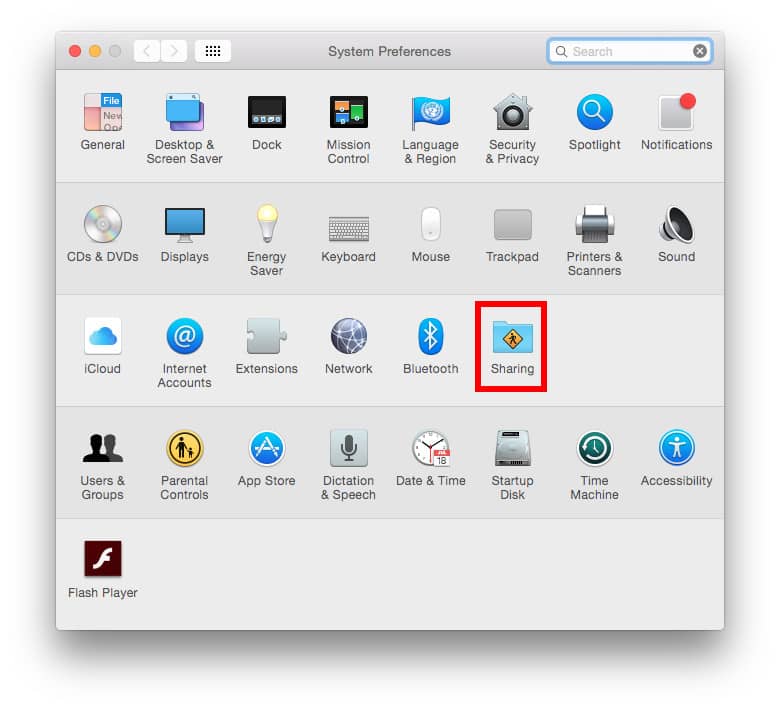
- Select Internet Sharing from the left panel. The Internet Sharing options will appear on the right side of the screen. Set the following settings: Share your connection from: [the VPN L2TP connection you just created] To computers using: Wi-Fi
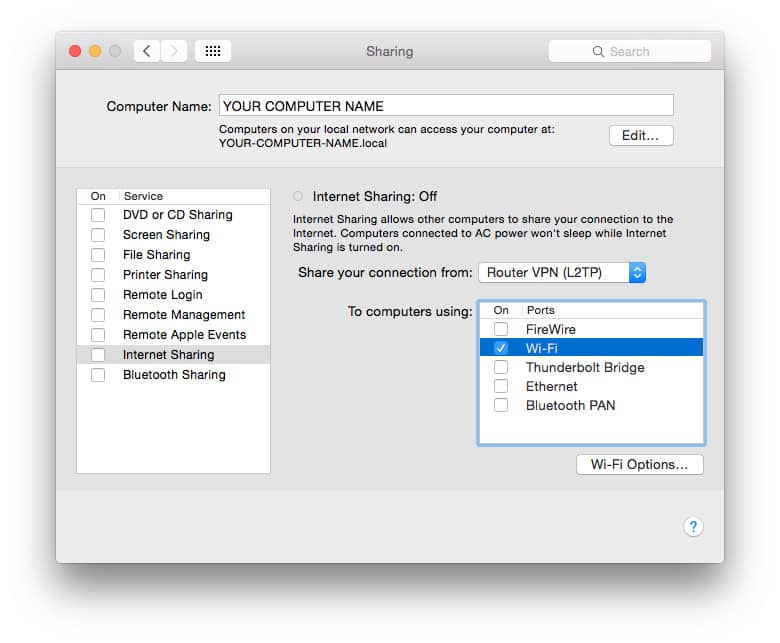
- Select Wi-Fi Options…, and enter the following details: Network Name: [choose a network name also known as an SSID], Channel: [leave as default], Security: WPA2 Personal, Password: [choose a password], Verify: [re-enter your password]
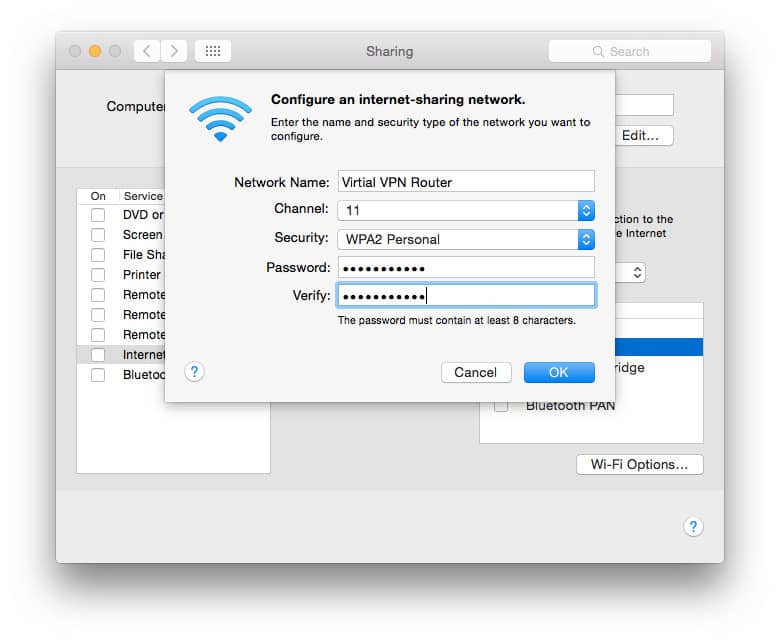
- Click OK. On the Sharing menu, check the box next to Internet Sharing. You will see a prompt asking you to turn on Internet sharing. Click Start. When Internet Sharing has been activated, a green light will appear next to the text: Internet Sharing: On
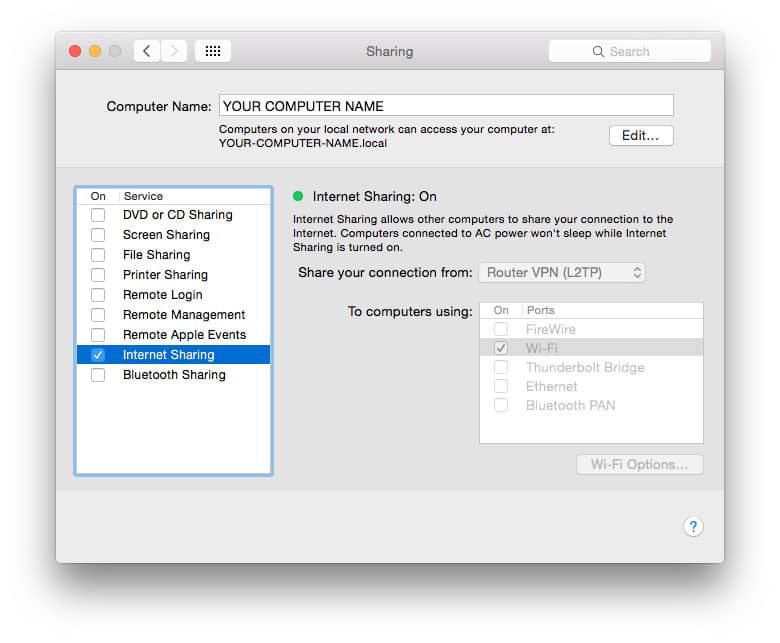
- In your menu bar, you will now see two new icons. The first icon shows your VPN connection status. The other new icon shows your Internet Sharing status.

- Open the VPN app and connect!
Method #4: Connect Fire TV to a VPN-enabled physical wifi router
Unfortunately, we can’t give you step-by-step instructions on how to set up a VPN on your home wifi router. Wifi routers come with a wide range of firmware, not all of which support VPNs, and those that do vary in their configuration processes.First, you need to find out if your router even supports VPN connections. You can check the bottom or back of your router for its local IP address and default login info, or you can use Google to find the credentials associated with your particular model. Usually you can type either 192.168.0.1 or 192.168.1.1 into your browser’s URL bar, and the most common username and password are both “admin”.
Once you’ve logged into your router’s firmware, look around for VPN configuration. For a typical L2TP/IPSec VPN connection, you’ll need your VPN provider’s server address, username, password, and shared secret.
If your wifi router doesn’t support VPN connections, check to see if you can replace the firmware with an open-source solution like DD-WRT, OpenWRT, or Tomato. This process of replacing the manufacturer’s firmware on a wifi router is called “flashing”. Use caution if you decide to go this route. Be sure that the firmware you download is compatible with your specific router. If you mess up, you could permanently damage the router and brick it so that it’s no longer usable.
If that’s not something you’re willing to risk, consider a pre-flashed router from a VPN provider.
No comments:
Post a Comment